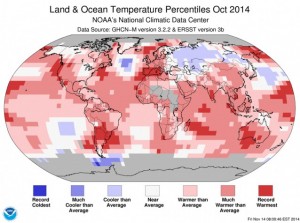UN Climate Talks: Just a Lot of Hot Air in Lima?
Dec 5th, 2014 | By admin | Category: Climate ChangeBy Suzanne York, www.howmany.org
Perhaps it’s telling that the UN climate meeting (officially known as COP 20) is being held in Lima, Peru. It is an arid city of more than 8 million people and growing that receives less than an inch of rain annually. With droughts increasing here and in many cities and regions of the world and human population numbers still growing, attendees would do well to take notice of their surroundings.
According to the National Oceanic and Atmospheric Administration (NOAA), the year 2014 is on track to be the hottest year on record. Despite this, negotiators will continue to argue over commitments and wording, politicians will bicker over human contribution to climate change, and more and more people will continue to consume resources at unsustainable rates. We are emitting record amounts of carbon pollution into the air as if nothing was at stake.
Reports and warnings about human-induced climate change seem to come almost on a daily basis. The evidence is undeniable, yet nothing much changes, or if it does, it does so at a glacial pace. Rajendra Pachauri, the UN’s top climate scientist, said at the start of the UN climate conference that the world has already used up 65 percent of its carbon budget (the approximate amount of greenhouse gases we can emit into the atmosphere if we want to maintain a reasonable chance of remaining below 2 degrees Celsius of warming.)
Climate Change and Population
Speaking of human impacts, what about population growth? Will it come up at the climate talks? Andy Revkin of The New York Times wrote that population is often left out of climate discussions, even though it contributes to both rising emissions of greenhouse gases and rising vulnerability to climate hazards in poor places with high fertility rates.
However, once in while population issues make it into discussions and reports. Earlier this year, the Intergovernmental Panel on Climate Change (IPCC) released the second volume of its Fifth Assessment Report – Climate Change 2014: Impacts, Adaptation, and Vulnerability” which noted “human interference with the climate system is occurring, and climate change poses risks for humans and natural systems.”
The Population and Sustainability Network analyzed references to population issues when the report was released. A few main points include:
- Non-climatic drivers such as population increase, economic development, urbanization, and land-use or natural geomorphic changes also challenge the sustainability of resources by decreasing water supply or increasing demand;
- Over the next few decades and for increases in global mean temperature of less than around 2 degrees Celsius above pre-industrial, changes in population will generally have a greater effect on changes in resources availability than climate change;
- The population and assets projected to be exposed to coastal risks as well as human pressures on coastal ecosystems will increase significantly in the coming decades due to population growth, economic development and urbanization.
The delegates should heed this. But more importantly, if there is to be serious action on climate, population issues shouldn’t be ignored.

Is there too much hot air at international climate negotiations? [photo credit:http://en.wikipedia.org/wiki]
Other issues that should be moved up on the UN climate agenda are family planning, alternative economies, rights of nature, indigenous rights and wisdom. But these topics are mainly relegated to unofficial side events.
The world is out of balance. That imbalance should be front and center at this gathering. In Peru, pressures of development are pushing extractive industries – especially water intensive industries such as mining – over people and the environment. Ironically, world governments are grappling with climate change one the one hand, and on the other pushing development that perpetuates the climate crisis.
We can’t have it both ways. There can’t be constant economic growth and continuing population growth and a have stable climate and sustainable environment.
It’s time to inject some fresh air into the global climate discussion.
Suzanne York is a senior writer with the Institute for Population Studies.

